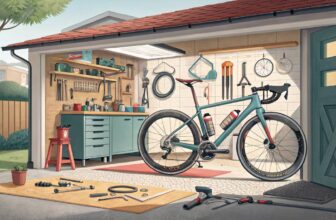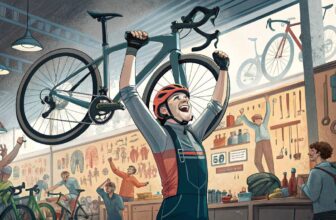Understanding Vintage Bicycle Posters
Vintage bicycle posters are a nostalgic treasure trove for both beginners and seasoned cyclists. They’re more than just cool art — they’re windows into the bike history world. We’ll check out what makes them unique and how to put a dollar sign on these gems.
Characteristics of Antique Posters
Antique bicycle posters come in all kinds of sizes and styles. Usually, they fall between 24-40 inches in width and 20-102 inches in height, though it isn’t a hard rule. Big, pristine posters can fetch more money than smaller ones, even if they’re in top-notch condition.
| Poster Size (Inches) | Common Range |
|---|---|
| Width | 24 – 40 |
| Height | 20 – 102 |
When poster art was in its prime in the Western world, these posters were brimming with bold colors, meticulous details, and eye-catching designs. Original lithographs, over a century old, are a hot ticket item, often embodying the golden days of cycling hype.
Valuation of Vintage Prints
Giving value to vintage bicycle posters means looking at their condition, rarity, and historical weight. Originals could run anywhere from $1,000 to $3,000, depending on how old and artistic they are.
| Condition | Estimated Value (USD) |
|---|---|
| Pristine | $1,500 – $3,000 |
| Good | $1,000 – $2,000 |
| Fair | $500 – $1,000 |
Want to make sure you’re buying right? It’s worth your while to get familiar with what makes these posters tick in terms of value. Loops to internal resources like how to test ride a bike and bike price guide might just fine-tune your bike-buying savvy.
Checking where the poster hails from can change the price tag significantly, especially if it’s by a famous artist or from a standout cycling period. Whether you’re a collector or a newbie, knowing these key points will help you spot genuine value in vintage bicycle posters.
Identifying Artistic Movements
So, you’ve got your eye on some vintage bicycle posters? Nice choice! These aren’t just pretty pics from the past; they tell tales of bygone eras. We’re talkin’ about Art Nouveau and Art Deco here, two art movements that left a lasting mark on cycling posters from the late 1800s to the early 1900s. Get to know these styles, and you might just become the poster-whisperer!
Art Nouveau Influence
Art Nouveau was all the rage from the 1890s up until World War I. Imagine swirling lines and nature taking center stage. That’s Art Nouveau for ya! When you’re peeping at a bicycle poster from this period, you might notice:
- Wavy Lines: Think vines and stems — lines that seem to move like leaves in a breeze.
- Funky Fonts: Fancy, twirling letters that feel like a dance on paper.
- Punchy Colors: Bold and bright, a color fiesta meant to pop and wow.
These quirky combos make posters that are both eye-pleasing and unique.
(Example of Art Nouveau Bicycle Poster)
Eager to dive deeper into what makes these prints tick? Hop over to our Valuation of Vintage Prints guide.
Art Deco Elements
Then comes Art Deco, stealing the limelight in the roaring ’20s and ’30s. Now, we’re talkin’ sleek and shiny, more glitz and glam. Art Deco jazzed up everything, right down to bicycle posters. Here’s what to watch out for:
- Shapes Galore: Like playing with building blocks — circles, triangles, and rectangles galore.
- Crisp Lines: Those outlines? Sharp enough to cut cheese.
- Loud Fonts: A type that shouts and demands attention, just like a headline in a tabloid.
Art Deco posters were perfect for a world moving fast into the modern age, where style met substance at the crossroads of art.
(Example of Art Deco Bicycle Poster)
Discover more about these cool visual themes over at our Themes in Vintage Cycling Posters section.
Being clued-up on these art styles makes it easier to spot hidden gems when you’re poking through posters at an auction. You’ll have the upper hand in recognizing the true value and avoid bidding wars gone wild.
Is your heart set on buying a bicycle too? Check out our bike price guide for nifty tips. Financing fears? Our bike financing guide tells you all you need to swerve those worries. And if you’re buying your first bike, our bike buying mistakes article has your back with a heads-up on what not to do.
Themes in Vintage Cycling Posters
Vintage cycling posters aren’t just about selling bikes; they also tell stories of societal shifts. Two big themes you’ll often spot are celebrating women gaining independence and the spotlight on cycling stars.
Empowerment of Women
Back in the day, these posters were all about women feeling free and empowered. The late 1800s and early 1900s were times when women hopped on bikes and felt newfound independence. Posters showed women not just cycling but breaking free and exploring the world on their terms.
Imagine this: women ditching corsets for bloomers, cruising in comfy gear that let them pedal with ease. The posters illustrated this shift, with open roads and rural backdrops symbolizing freedom from societal norms. Wanna dive into this wave of change? These vintage pieces give you a peek into how bicycles were game-changers for women (Love to Know).
Promotion of Cycling Icons
Another strong vibe in these posters is celebrating cycling legends and popular brands. Think of titles, like “Tour de France,” where champs like Jules DuBois and G. Poulan made a name for themselves. Their faces on posters were like a call to action, making people want to start cycling themselves.
What did the brands get out of it? Major loyalty points. By linking their bikes with well-known athletes, they hoped folks would keep coming back for their wheels. Seeing these talents dominate the roads inspired regular Joes to dream big too.
To give you an idea:
| Cyclist Name | Bicycle Brand Promoted |
|---|---|
| Jules DuBois | Excelsior |
| G. Poulan | Alcyon |
If you’re hitting up a motorcycle auction or just love old-school bikes, knowing the backstory on these posters makes the trip down memory lane a lot richer. Curious about bike prices? Check out our handy bike price guide for tips on how to size up these vintage gems.
These themes aren’t just for looks. First-time buyers, aspiring cyclists, and collectors can soak up the broader picture of these posters’ historical heft. Ready to uncover more purchasing experiences and tips? Hop over to guides like where to buy bikes, how to test ride a bike, and bike brand reputation.
Maximizing Motorcycle Trade-In Value
Getting top dollar for your motorbike isn’t just about luck—it’s a savvy mix of fixing things up and having your paperwork ducks in a row. Let’s break down how to score the best deal on your trade-in.
Mechanical Repairs and Upgrades
Fixing up your bike can really boost how much it’s worth when you trade it in. Sorting out pesky problems like dodgy brakes, a rusty chain, or flickering lights is really a must-do. With everything running smooth, your bike not only becomes more dependable but it catches eyes for all the right reasons. Even little, cheap tweaks can make a big difference.
Upgrades are also game-changers. Here are some popular ones:
- Brake System: Swapping in high-performance brakes gives you better safety and riding control.
- Exhaust System: A new exhaust not only sounds cool but also boosts engine performance and style.
- Suspension: A new suspension can make your ride feel silky smooth and easier to manage.
And don’t skip the cleanup! A shiny, clean bike shows you’ve given it TLC. A good wash, polish, and a bit of wax can make your ride look almost new, which gives the impression it’s been well looked after.
| Component | Average Cost ($) | Potential Value Increase (%) |
|---|---|---|
| Brake System | 100 – 300 | 10% – 15% |
| Exhaust System | 200 – 600 | 15% – 20% |
| Suspension | 150 – 500 | 10% – 15% |
Importance of Maintenance Records
Keeping track of all the nips and tucks you give your bike can really pay off when it’s trade-in time. Detailed records of what’s been done, when, and with what parts show that you’ve put in the effort to keep your bike in tip-top shape.
Here’s what your records should ideally include:
- Service Logs: Write down when and what got fixed or serviced.
- Upgrade Documentation: Describe any add-ons or changes in detail.
- Original Receipts: Keep proof of purchase and service for parts and repairs.
These records are your bike’s resume. During trade-in talks, they provide clear evidence and can easily argue for a bigger payout.
Another trick to squeezing out more value is knowing just what your bike’s worth. Use online tools, dig into some market research, keep an eye on depreciation rates, or get someone who knows what they’re doing to appraise it properly. Check out our bike price guide for a hand in nailing down your motorcycle’s worth.
For all things buying, selling, or just keeping your bike running smoothly, and to dodge any dumb mistakes, check out our articles on bike buying mistakes and bike maintenance plans.
Factors Affecting Trade-In Value
Trading in your motorcycle ain’t just about handing over the keys. Nope, there’s a whole slew of things that’ll bump up or knock down the bucks you get. We’re talking about your bike’s miles, accidents it’s seen, and how you’ve looked after it.
Mileage and Condition
First off, let’s chat about how far your bike’s been ridin’. Those odometer numbers matter big time. Think of it like a dating profile—more miles suggest it’s been around the block a few times. Fewer miles, less wear and tear, means more dough for you.
| Mileage (in miles) | Expected Condition | Trade-In Value Impact |
|---|---|---|
| 0 – 5,000 | Top-notch | Ka-ching! |
| 5,001 – 20,000 | Still lookin’ good | Not too shabby |
| 20,001 – 50,000 | Seen better days | Wallet’s getting light |
| 50,000+ | Rough around edges | Might need luck |
Keeping your bike in top shape counts too. Whether it’s fixing those squealing brakes, tightening a loose chain, or sorting out that flickering headlight, all this TLC can boost what you’re offered.
Need more tips on sprucing up your bike’s worth? Hit up our bike trade in value page.
Incident History and Repairs
Your bike’s backstory? Oh, it ain’t just about the wind in your hair and the bugs in your teeth. It’s the scars it carries. If it’s been in a dust-up or serious repairs have been needed, that impacts its trade-in value.
Consider these:
- Incident History: Got a spotless record? The ache to keep it that way. Bumps and crashes on the resume scare off buyers faster than a skunk at a picnic.
- Quality of Repairs: A bike patched up in some dodgy back alley probably won’t hold value like one fixed at a reputable shop. It’s all about quality, baby.
Being upfront with repair history and maintenance logs not only eases negotiations but can also sweeten your trade-in deal.
Got incidents or repairs neatly documented, with receipts in tow? You got yourself some transparency points, which could just tip the scales in your favor. Our piece on document bike condition has some nitty-gritty insights on keeping those records tidy.
All these bits and bobs give you the knowledge to get the best trade-in offer out there. For more on sizing up a second-hand ride, see used bike inspection.
Navigating Motorcycle Auctions
Motorcycle auctions can feel a bit like a rollercoaster ride for newbies and experienced riders alike. Let’s keep it smooth by diving into the must-dos for a successful spin around the auction track.
Researching Auction Policies
So, you’ve got your eye on a shiny set of wheels at the auction? Hold your horses! First, it’s smart to dig into the fine print of the auction house rules. They all have their quirks:
- Deposit Dramas: Most places want a slice of your dough upfront as a deposit to join the bidding party. Your mileage may vary here, so check out each auction’s specifics.
- Registration Hustle: Gear up with your ID and proof that you’ve got the funds. Some auctions let you register online beforehand, making the big day less of a mad dash.
- Sneak Peeks: Get there early to give the bikes the once-over. Some spots offer a special window just for lurking and looking. Spotting any quirks beforehand can save you a headache down the road.
- Sale Talk: Know the lingo, especially all those little extras you might need to cough up when you win.
Being clued-up on these details helps you bid confidently and steer clear of any curveballs.
Payment and Post-Auction Drama
Bagging that bike at an auction? That’s just lap one! Now we deal with the after-party:
- Tick-Tock Deadlines: They want their money, and they want it fast. Pay up on time, or else you’ll face extra charges like $100 for being tardy with payments and $50 for playing hide-and-seek with storage fees. Make sure your wallet’s ready to rumble.
- Cash or Card?: Clarify how they’ll take your payment. Cash, bank transfers, and maybe the old credit card are usually on the table but always double-check.
- Paper Trail: Don’t ride off without the paperwork — snag that bill of sale and title like it’s a winning lottery ticket. It’ll make transferring ownership a breeze.
| Auction Bit | Why It Matters |
|---------------------------|---------------------------------------------|
| Deposit Dramas | To get in the bidding game |
| Registration Hustle | ID and money proof needed |
| Sneak Peeks | Early bird gets the worm (or the bike) |
| Tick-Tock Deadlines | Dodge those nasty late fees |
| Cash or Card? | Confirm payment options |
| Paper Trail | Must-have for ownership swap |
Want to know more about shelling out the cash for your bike? Check this guide.
Nailing these payment and post-auction tasks smooths the path to bike ownership. Remember, always double-check that VIN and scope out the item’s history, because who needs extra surprises?
For the nitty-gritty on buying safely at auction, hit up our guide on why you should verify the VIN. Happy bidding — may the bike be with you!
Types of Motorcycle Auctions
When trying to score a snazzy ride without burning a hole in your pocket, picking the right motorcycle auction is a game-changer. There’s a whole gumbo of options out there, and knowing what’s what can keep your money where it belongs—right in your wallet. Here, let’s chew over wholesale, online, and salvage auctions.
Wholesale and Online Options
Wholesale auctions are like hidden gems. Here, dealers wanna shuffle off some two-wheelers ASAP, tossing them out at prices that might make you feel like you’ve hit the jackpot. It’s like that feeling when you find a $20 bill in your old jeans. Bargain hunters rejoice!
Ever tried auctioning without leaving your couch? National Powersport Auctions makes it possible with online bids for motorcycles and some fun extras like ATVs and boats. With spots sprinkled around the country from Atlanta to Dallas, it’s as easy as pie to dive in from afar.
| Auction Type | Notable Locations | Inventory |
|---|---|---|
| Wholesale Auctions | Big cities | Motorcycles, ATVs, Boats |
| Online Auctions | Your home (or wherever you fancy) | Motorcycles, Cars, Boats |
Still, scratching your head about how much to shell out? Give our bike price guide a look-see.
Salvage Motorcycle Auctions
If you’re the tinkering kind with a dash of patience, or just out for a killer deal, salvage motorcycle auctions might be your gold mine. Think of them as the clearance aisle for bikes—great for project lovers and parts hoarders alike.
Take CrashedToys, where you’ll find rugged deals on salvaged motorbikes. They’re hanging out in places like Sacramento and Minneapolis, with some fab finds for anyone with a wrench and a dream.
| Auction Type | Notable Locations | Inventory |
|---|---|---|
| Salvage Motorcycle Auctions | Cities like Sacramento, Atlanta, Dallas | Salvage Motorcycles, ATV, RVs |
Don’t get too starry-eyed; be sure to poke around anything salvage-y before you seal the deal. Check our handy used bike inspection guide for tips that’ll keep surprises at bay.
Each auction has its flavor, so figure out which one clicks with your style and stash. Want more smart ways to spend that dough? Peek at our tips for successful auction bidding and cruise away with your next motorcycle triumph under your belt!
Tips for Successful Auction Bidding
Bidding at bike auctions can be a thrilling adventure, especially if you’re diving in for the first time or trying to stretch your dollars. Being prepared can make all the difference. Here’s a quick guide to help you snag that dream bike without losing your cool—or your cash.
Pre-Auction Prep
Prep work is the secret sauce of bidding success. Start with a little detective work on the auction house you fancy. They’ve all got their own rules, and you don’t want any surprises once you’re in the thick of things. Keep your eyes peeled for:
- Kick-off Prices and Hidden Thresholds: Know if there are any basic bids or reserves at play.
- Ways to Place Your Bet: Can you bid online or is it old school all the way? Check it out (bike price guide).
- Fine Print Fun: Dig into those terms and conditions—stuff like deposits and signing up.
Turn up early or make the most of early viewing days to give the bikes a once-over. Some places even let you sneak a peek ahead of the big day, so you know what you’re getting into.
Budgeting & Inspections
Lock down a budget and don’t budge. Overbidding? A ticket to Stress City, especially when you add on all those extra charges like buyer’s premiums or potential fixes.
| Cost Factor | Estimated Extra Cost |
|---|---|
| Buyer’s Premium | 10-15% |
| Auction House Fees | 2-5% |
| Credit Card Fees | 1-3% |
| Fixer-Uppers | Varies |
| Getting it Home | Varies |
Once you’ve got your budget nailed down, give those bikes a good look over. Bring your own tools or hire an expert, whatever it takes to dodge surprise repair bills. Check out our used bike inspection guide for the full rundown, because nobody likes unexpected repairs.
More helping hands:
- Dive into all the costs of buying with our how to pay for bike guide.
- Weigh up different bikes with our compare bike specs.
- If auctions aren’t your vibe, check where to shop online with our where to buy bikes online.
Stick to these pointers and you’ll roll out of the auction with a bike you love at a price you feel good about. Happy bidding!
Making Auction Purchases Safe and Sound
When diving into the exciting world of motorcycle auctions, ensuring a secure transaction and verifying the motorcycle’s authenticity are crucial. Two main moves? Checking that VIN and sussing out the vehicle’s history reports.
Why Check the VIN?
The Vehicle Identification Number (VIN) might sound fancy, but it’s a non-negotiable when scoring a motorcycle or car at an auction. The VIN’s like a magical code that uncovers the vehicle’s true story—from ownership shenanigans to accident drama and even if it’s ever been recalled for safety tweaks.
What You Get With VIN Verification:
- Spotting Fakes: Make sure you’re not buying a stolen ride or some shady deal.
- Owner Scoop: Know who’s owned it, if it’s got a clear title, and dodge any legal mess.
- Crash Course: Dig into any past crashes; these might shrink the bike’s value or mess with its safety.
Curious about diving into used bike inspection like a pro? Head over to our used bike inspection guide.
Getting the Lowdown on Vehicle History
Snagging a vehicle history report through that trusty VIN hands you juicy info like accident tales, maintenance logs, and who used to own it. This secret stash helps buyers figure out the real condition of the vehicle, unearths hidden problems, and checks if it hits their checklist of needs.
Plus, with that VIN in hand, buyers can peep into any lurking safety recalls. You’ve gotta make sure repairs are set before sealing the deal.
| Report Type | What’s Inside |
|---|---|
| Accident History | A rundown of past smashes and how bad they were. |
| Maintenance Logs | All about regular fixes and any massive mends. |
| Previous Tags | History of who owned it and where it claimed home turf. |
| Safety Check | Lists any unaddressed recalls and checks if safety mods happened or not. |
Got a trade-in on the brain? See how upkeep and crash logs impact the value by checking our bike trade in value section.
Throw in VIN verification and full-throttle history reports, and buyers can ride away with confidence and deal security at motorcycle auctions. Need more hints on smart auction tactics? Peek at our piece on bike auction strategies.




